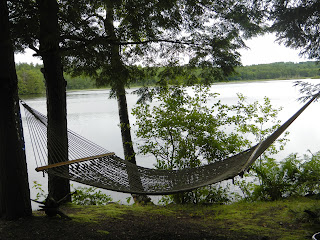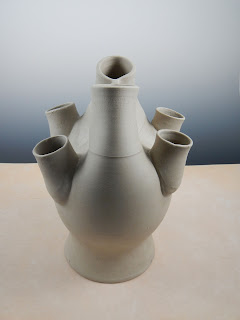Today was FULL.
First thing was introductions. We all stood in turn and said our names and something about ourselves. We are only 44 attendees, so this was easy. It's always fun to meet other potters.
After that, our five presenters demonstrated technique. They were in two studios, and we could come and go as we wanted to see whomever in either room. They did the first part today in the morning, and the second part after lunch.
 |
| Lisa Clague |
Lisa Clague built the first part of her sculpture from big, flattened coils of clay. As she builds the piece she draws on it, butters the surface with slip in places, and sometimes (see the small sculpture at her elbow) incorporates metal objects. She will add the head tomorrow. I think it will surprise you.
 |
| Tip Toland |
Tip Toland built much of the head and shoulders of a figure. She will continue tomorrow, too. Along the way she explained proportion and structure of the human head. She was so funny and charming, it will be a contrast to see the finished piece, which will tend, she told us, toward melancholia. She added that her sculpture tends toward the dark side. If you find her work online, you will know what she means.
 |
| Ellen Shankin |
In the second studio, Ellen Shankin threw pots. Throwing is the technique closest to my heart, which I use most. but every potter has his or her own influences and style, and it is really a blast to see Ellen's. Here are some of the Phase 1 pots, to be assembled or altered or added to tomorrow in Phase 2:
In the same studio as Ellen Shankin, Mary Barringer worked on slab pieces.
 |
| Mary Barringer |
Mary doesn't use much color, but builds up lots of surface intensity with texture and thin washes of glaze. Her forms are simple and rely a great deal on individual nuance to give them strength. Throughout her presentation, she tried at length to talk about her objects and their meanings. It is difficult to express the ideas within objects. As editor of Studio Potter, she is always thinking through ideas that frame the "language of clay." I found it challenging to assimilate some of her ideas. I am not used to thinking in this way.
 |
| Donna Polseno |
While Ellen and Mary were two in this session in the first part of the day, Donna Polseno joined them after lunch to make three presenters in this studio. Donna teaches at Hollins University, and organized this symposium. She slipcasts her forms (from original pieces she makes herself) to obtain the right shapes, then adds to the cast pieces with additional parts. These lively forms are sometimes vessel, sometimes form, and sometimes a hybrid.
After this, the whole group had a writing session where we wrote an ode to something. Mine was to my studio, and boy, does it need revising. I missed most of this, as it happens, because I was so tired from all the information I was absorbing that I slipped out to my room and took a brief nap.
In the evening, after dinner, the presenters gave a slide show with photos of their work. It was very telling to hear influences that formed phases of their potting lives. I was heartened by something Ellen Shankin said, in reference to the shows of a group of potters in Virginia, Sixteen Hands, of which she is part. She said, "We were all 25 years into this before we tried to get people to find us."
Hmm. I started my studio in 1987. It's a happy quarter century in clay for me. Who knows where next year will find my work?






























